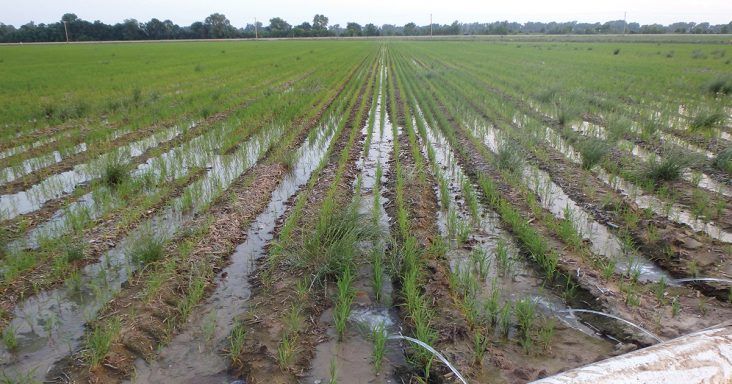USDA to undertake rare extra data collecting on crops
by August 11, 2019 9:34 pm 748 views

Photo courtesy of UA System Division of Agriculture.
Arkansas’ weather-volatile planting season has been reflected in the recently released United States Department of Agriculture’s National Agricultural Statistics Service acreage report, with the agency saying it would be collecting additional information on the state’s soybeans and cotton.
NASS reported that in July it would collect information on crops in 14 states, including a recount on soybeans and cotton in Arkansas, since neither had reached 100% completion in planting when the acreage report was issued.
“Excessive rainfall had prevented planting at the time of the survey, leaving a portion of acres still to be planted,” the NASS report noted. If new data justified changes, updated acreage estimates would be published on August 12. The last time NASS had to go back to the fields for info was in 2015.
Jarrod Hardke, extension rice agronomist for the University of Arkansas System Division of Agriculture, said he could see this coming months ago.
“Starting back in January, I felt this was going to be the hardest year in recent memory to predict,” he said. “And then the year got worse.”
Corn
Corn was estimated at 810,000 acres, down from the 830,000 acres in the March report. Scott Stiles, extension economist for the University of Arkansas System Division of Agriculture, said the corn acreage surprised him. Based on the Friday report, this would be the highest corn acreage for the state since the 880,000 reported in 2013.
“I really thought we’d be down below 700,000 and about unchanged from last year … I think a strong price rally in corn encouraged growers to keep planting later than normal,” Stiles said. “From mid-May to mid-June, September corn futures rallied over $1 per bushel — trading up $4.68 on June 17.”
Cotton
NASS reported 580,000 acres of cotton, matching its estimate from the March “Prospective Plantings” report.
“This would be the fourth year of increasing cotton acreage and the highest planted acreage since 2012, when Arkansas had 595,000 acres,” Stiles said.
Extension Cotton Agronomist Bill Robertson said that according to the Arkansas Boll Weevil Eradication Program, Arkansas growers enrolled 583,770 acres, just above NASS’s report.
“This number could change some as a result of flooding,” he said.
Peanuts
“NASS delivered the peanut acreage we were expecting in March,” Stiles said. “45,000, versus 25,000 predicted in March.”
Travis Faske, extension plant pathologist for the Division of Agriculture, said an increase of “approximately 20,000 acres over last year was due to the new peanut company, Delta Peanut.” Delta Peanut was planning to build two buying points and a shelling plant in Arkansas.
Soybeans
Extension Soybean Agronomist Jeremy Ross said he wasn’t surprised by the 3 million acre figure. However, “it is shocking to see the number of fields across the state that have bare ground with no crop planted,” he said.
NASS estimated that 89% of the Arkansas soybean crop has been planted. Producers can still plant and harvest a soybean crop with July planted soybeans, but time is running out, he said.
“Compared to the optimum planting date, we have already reduced our maximum yield potential by 25 to 30% with late plantings. Every day we delay planting is reducing the yield potential.”
Ross said another concern was that planting soybean maturity groups IV and V, much later than mid-July would run the “risk of not being fully mature by the time we typically have a frost in late October to early November.”
Stiles said that “as recently as mid-May, November soybean futures were trading down at $8.15 per bushel — at decade lows. Slow export demand and record large supplies have kept basis levels weak.”
“The market hasn’t had to encourage growers to plant soybeans,” he said. “Progress on trade talks with China has been slow as well. That continues to be an overhang on the soybean market.”
The soybean acres were the lowest since the 2.85 million planted in 2007.
Rice
“Rice acres were really surprising,” Stiles said. “The March intentions had Arkansas at 1.4 million total for long and medium grain. Today’s numbers came in just 100,000 acres below that. Maybe improving rice prices kept growers adding acres.”
Hardke said he thought the number of acres was high.
“There are plenty of areas in the state that had high prevented planted acres,” he said. “Based on conversations with growers, I still feel like our total rice acreage number will be about 1.1 million.”
“There’s so much variability out there in what happened in small regions of the state and how much they were impacted by the weather and what percent they were able to get planted,” Hardke said.
He was also predicting a record high number of prevented planting acres for rice when then numbers come out in August. The previous record was 302,000 “and change” in 2013, he said. “We’re going to beat that number.”
NASS hasn’t predicted that Arkansas rice planting is at 100% complete. September rice futures increased about $1.50 per hundredweight from late April through early June — trading just over $12 per hundredweight at its peak.
“With soybeans not providing an economical alternative, growers continued to plant rice,” Stiles said. “When the calendar flipped to June, there were indications that folks weren’t through planting their intended rice acres.”
